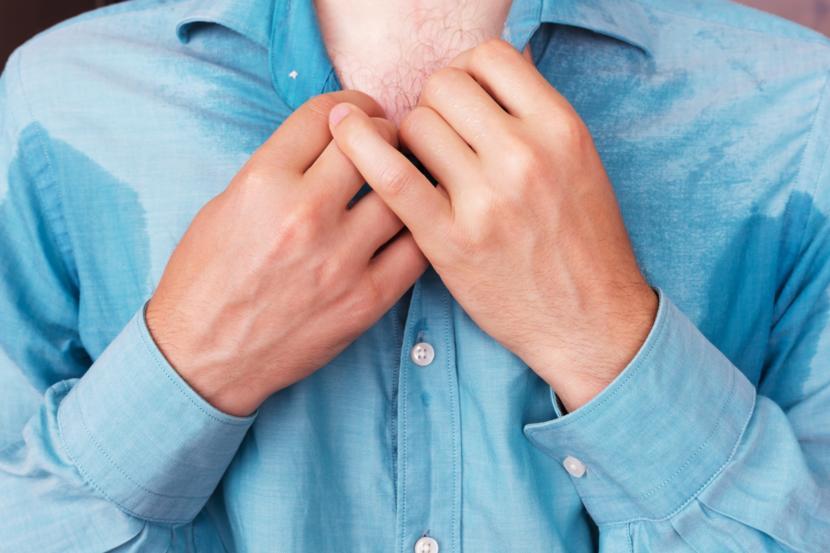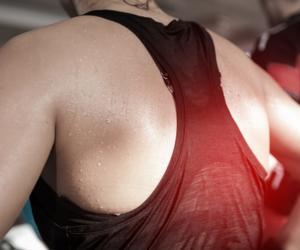5 Treatments for Excessive Sweating

What is excessive sweating?
Excessive sweating is also known as hyperhidrosis. Abnormal and excessive sweating is not necessarily related to a rise in body temperature or intensive exercises. In this condition, sweating is so excessive that it tends to soak the clothes of an individual. At times, sweat can also drip from the hands.
Hyperhidrosis can cause social embarrassment or anxiety aside from causing a disruption to one's daily routine. The treatment for excessive sweating would involve certain antiperspirants that can be applied to the affected regions.
In rare cases, the main reason for excessive sweating would be an underlying medical condition. For continuous sweating, the doctor can provide various treatment options or therapies until the correct one suits the need. If the condition becomes worse, the doctor can recommend surgery to remove sweat glands or disconnecting the nerves, which are responsible for the overproduction of sweat in the body.
5 Treatments for Excessive Sweating
When it comes to treating excessive sweating, the main goal is to appropriately control the condition. Doctors can conduct a physical examination along with taking a patient's medical history to rule out any underlying medical conditions. Treatment usually depends on the patient's condition and severity of the issue.
In certain cases, an individual would need to go in for a combination of treatments to achieve the best results. However, there is also a possibility of recurrence after the excessive sweating improves. Restarting the therapy would be necessary in such cases. Let’s have a look at the various treatment methods for this issue:
1. Antiperspirants
One of the easiest methods to deal with the problem of excessive sweating is with the use of antiperspirants, which most people already use on a daily basis. Aluminum salts are the most common active ingredients of antiperspirants. When these antiperspirants are rolled onto the skin, they tend to form a plug that blocks and limits perspiration. Antiperspirants can be purchased from any local supermarkets or drugstores. It can also be prescribed by the doctor.
Over-the-counter antiperspirants can be less irritating to the skin than the prescription ones. It is better to start with an over-the-counter brand of antiperspirant, but if it does not work well, then you can go to the doctor and ask for a prescription antiperspirant. Certain antiperspirants such as Drysol or Xerac Ac can be considered as the first line of treatment. These products are known to cause skin and eye irritation, so they can only be applied to the affected regions before going to bed.
When you wake up in the morning, you can wash off the product from the skin. In case of a skin irritation, hydrocortisone (topical steroid) creams can provide some relief. These antiperspirants are usually sold along with deodorants, which do not help in stopping the sweat, but can only help in controlling the odor from the sweat.
These antiperspirants are not only for underarm applications. They can also be applied to other parts of the body, where there is excessive sweating such as the hands or feet. In some cases, these antiperspirants can also be applied to the hairline to control sweat.
If the antiperspirants are not helping in any way, then the doctor can recommend other treatments options.
2. Iontophoresis
In this particular treatment, the patient would need to sit with the hands and feet or both in a shallow tray of water. The patient needs to stay in this position for about 20-30 minutes. There would be a low electric current, which would travel through the water. Experts say that this treatment method tends to block the sweat from getting to the surface of the skin. This treatment would need to be repeated for at least a few times a week.
After undergoing several procedures of this treatment, the sweating would gradually stop. Once the patients know how to do iontophoresis, then they can buy a machine, which they can use at home. In certain cases, few people would require a couple of treatments a month as a form of maintenance.
Most of the time, iontophoresis is considered safe, but since it uses an electrical current, it is not suitable for pregnant women and individuals who have pacemakers or metal implants in their body. It is also not recommended for individuals with heart problems and epilepsy.
3. Anticholinergic Medications
Doctors can recommend anticholinergic medications to people who have already tried using antiperspirants and various treatments such as Botox and iontophoresis but without significant improvements.
These medications can stop the activation of the sweat glands by blocking the chemicals that give permission to nerves to effectively communicate with each other. However, these medications are not recommended for all individuals since they also come along with their own set of side effects, which include vision troubles, urinary problems, and heart palpitations.
4. Botulinum Toxin
Botulinum toxin A (Botox) can be used for the treatment of excessive underarm, hand, and feet sweating. It can be given several times via injections and may last for a year. It is the same medicine given to reduce wrinkles. The use of Botox is also FDA-approved.
The medicine works by preventing the release of a certain chemical that signals the sweat glands to become active. Further research is still required on the possibility of any side effects when used as a treatment option for excessive sweating.
5. Surgery
Surgery is usually the last option necessary for people who have severe hyperhidrosis or those who have not responded to any of the above treatment options. During the surgical process, the sweat glands may be cut out, scraped out, or removed through suction.
Endoscopic thoracic sympathectomy (ETS) is another surgical method for hyperhidrosis, wherein the surgeon makes very small incisions and then cut the nerves that activate the sweat glands in the armpit. This procedure is said to be quite effective, but should only be considered as a last resort by people who have tried all other options.
Once ETS is performed, it cannot be reversed back. It also tends to leave some scars after the operation. One of the other side effects of the procedure is compensatory sweating, wherein the body stops sweating in one area but starts to sweat in another such as the face or chest to compensate.
If there has been an occurrence of excessive sweating only in the armpits, then the doctor can suggest the removal of the sweat glands. The doctor can use one of the many techniques such as making a small incision through which the sweat glands can be scraped out or sucked.
Natural Remedies
Apart from the above-mentioned medical procedures and therapies, there are certain home remedies or lifestyle changes, which people can include into their daily routine to effectively cope with excessive sweating. The following tips can naturally help in reducing excessive sweating:
- Wear Breathable Clothes - Avoid wearing clothes that are too thick and heavy since they can trap sweat. Opt for lighter and breathable fabric, which includes cotton or silk. It is ideal to bring along an extra shirt when exercising or going outdoors in the heat.
- Take a Bath Regularly - It becomes important to have a bath on a regular basis, especially if you are one of those people who profusely sweat. Regular bathing would help wash off bacteria present on the skin. After taking a bath, make sure to dry yourself thoroughly, especially in between your toes and underarms.
- Wear Suitable Shoes and Socks - Feet and legs also tend to sweat a lot, so it is important to choose your socks and shoes wisely. Choose natural materials such as leather. It will allow your feet to breathe with a lesser accumulation of sweat. If you are active, you can wear moisture-wicking athletic socks. It is ideal to alternate your shoes instead of wearing the same shoes always. Shoes do not completely dry out, so always maintain two pairs of shoes to be alternately worn.
- Proper Foot Hygiene - Socks should be changed once or twice a day. Before wearing new socks, make sure to thoroughly dry your feet. Women can wear a pantyhose with soles made of cotton. You can use over-the-counter foot powders to absorb sweat and reduce odor.












